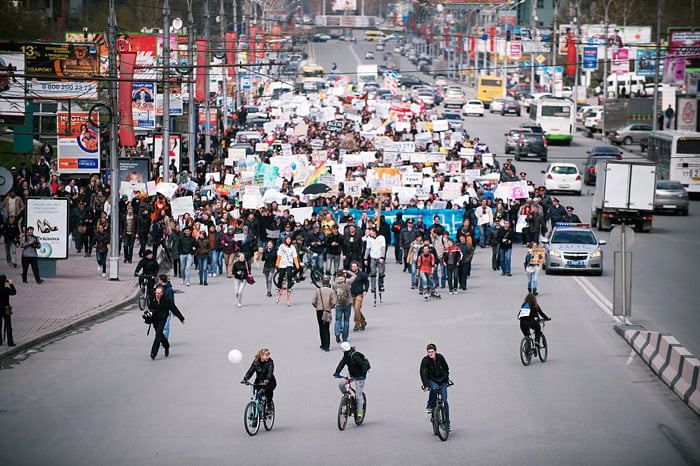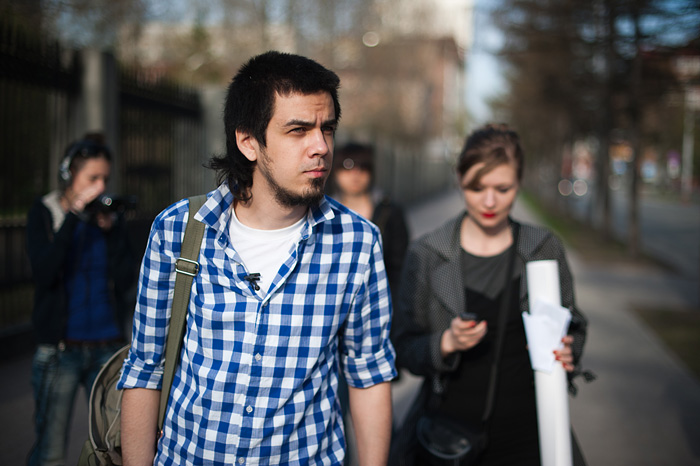On the streets: how a performance art movement is rallying crowds

Can a public rally be a work of art? Ask the Monstration movement
May Day mass demonstrations used to be a trademark feature of Soviet life. Military parades, official speeches, processions with red flags and banners all praising the ideals of the working masses. With the collapse of the Soviet system those demonstrations have lost their original meaning. But they continue out of tradition, often as an excuse for protests by different political parties.
Artyom Loskutov, a young artist from Novosibirsk, is aiming to bring new meaning to the May Day demos by replacing ideology with absurdity. In 2004, he staged a May Day event on the streets of Novosibirsk called Monstration. Some 80 people joined him on a march through town, carrying placards and posters bearing slogans gleefully stripped of politics or logic: “So what”, “We are not vegetables”, “Yesterday was Tuesday, but today is Tuesday as well.”
Monstration marches have taken place every year since and have spread to 20 cities including Moscow, St Petersburg and Vladivostok. In 2009, he was arrested for disturbing the peace after organising one of these events. In 2010, Loskutov was awarded the Innovation prize, Russia’s equivalent of the Turner Prize. And Monstration events now attract over 2,000 participants. Even as the happenings grow in scale and significance, they continue to retain their absurdist core. Improvisation and carnival are crucial elements, with participants dressed in costume and even greeting the changing of traffic lights with a loud cheer.
How did the first Monstration come about?
Artyom Loskutov: Monstration was an experiment in rethinking the city environment and particularly the May Day demonstrations, which had long lost their original meaning. I’d gone to several May Day demonstrations before and they seemed like a weird ritual. You’re supposed to take part but hardly anybody knows why. It seems like complete nonsense. That’s what we wanted to emphasise. Monstration is both a critique and a concept. We wanted to bring the May Day demonstration back to life but we also wanted to create a cultural event. But as there weren’t that many of us, we didn’t feel as if we could accomplish something on our own so we decided to work with the demonstration, integrating ourselves into it and transforming it from the inside.

Artyom Loskutov at a rally
Who were the founders of Monstration?
AL: There were about seven people who helped make banners the night before the first Monstration. It was mainly friends and friends of friends who came along. Some people went to the May Day demonstration, saw that we were younger and more fun than the official marchers and joined us. On the day, one of the organisers was arrested. He had been carrying a banner with the slogan: “Make love, not work.” Another was arrested carrying a “Closed” sign, which she had removed from a shop door. The invitations to the first Monstration were signed by members of the Contemporary Art Terrorism group. One of Monstration’s organisers, Max Neroda, was doing projects under this title before Monstration. He would go into exhibitions and hang his own paintings on the wall, in an act he described as art-terrorism.
How has Monstration changed over the years?
AL: Despite superficial changes, the essence has remained the same. In the first few years we used to joke about how it would take us 100 years to catch up to the number of official marchers; in the end, it only took us six. In 2010, Monstration separated from the May Day demonstrations because it was twice the size of the main march. You could even say that we took over the May Day parade: it’s no longer a day of Communist demonstration, but a day of Monstration.
“We took over the May Day parade: it’s no longer a day of Communist demonstration, but a day of Monstration”
Monstration has spread to other cities. Does Novosibirsk still have the highest number of participants?
AL: It does and always will I think. Initially our following grew quite organically but then I was arrested in 2009 and suddenly Monstration became famous outside Novosibirisk, while in the city, it turned out to be the largest gathering of its kind. These days, Monstration in Novosibirsk attracts around 3,000 to 4,000 people while most other cities manage about 300. It didn’t even take off in Moscow because of the political situation and the protests in 2012. The liberal protest movement tried to organise a Monstration but it wasn’t convincing as their rhetoric was too anti-Putin. Some people think that because Monstration doesn’t express loyalty to the authorities, it’s part of the opposition even though participants may not see it this way.
How did you respond to winning the Innovation prize?
AL: It was a surprise of course, but I guess things were heading that way. In that year in particular, the main prizes were being given to controversial works of art — Voina’s Dick Captured by the KGB and Monstration. It’s great because it’s as if I now have an official permit from the Ministry of Culture.
